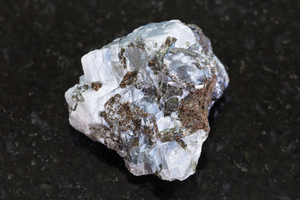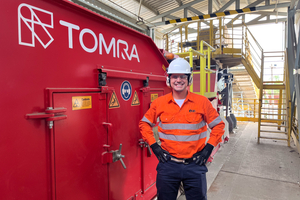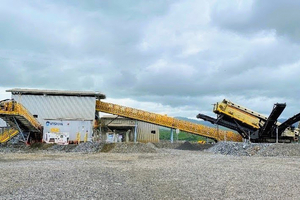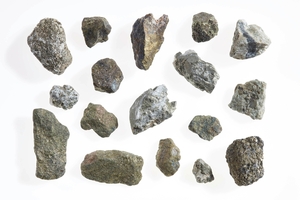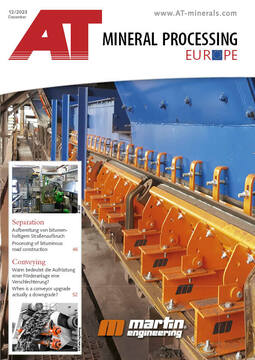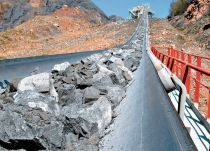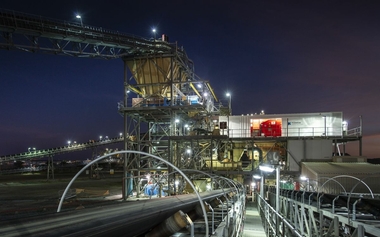Sensor-based sorting of sulfide ores
Sulfide minerals are the source of metals such as copper, zinc and lead, which have a key role to play in our modern lifestyle – with uses ranging from the energy supply, electronics and transportation to construction and infrastructure. The increase in demand for these three metals is expected to accelerate, driven by a variety of factors, such as infrastructure development, the rising demand for electronics and, very importantly, the transition to a low carbon economy.
In fact, they are among the critical raw materials required for the electrification of the economy, moving from fossil fuels to wind and solar power generation, and battery or fuel-cell electric vehicles (EVs). Copper is an essential driver of the energy transition for its uses in electrification, including the charging infrastructure for EVs and, according to a report by the International Energy Agency, the world will need between 1.7 to 2.7 times as much copper in 2040 as it produces today. The global zinc demand for renewable energy technologies is forecast to increase consistently to reach 364 000 t in 2030, up from 109 300 t in 2020, as stated in a Statista report. The value of the global market for copper and zinc is expected to reach US$ 394 billion and US$ 49.6 billion respectively between 2027 and 2030. The lead market is also expected to flourish, driven by the growing demand for energy storage, the accelerating adoption of EVs, and integration of smart-grid technologies.
The next ten years will be decisive for the decarbonization of world economy, and mining companies face the challenge of supplying the raw materials such as copper, zinc and lead, which are critical to the process. This means finding ways of extracting these minerals as efficiently as possible to meet the booming demand, while maintaining their operation financially profitable and minimizing their impact on the environment.
The main sorting challenge: waste removal
When processing sulfide ores to extract copper, zinc or lead, the focus is on ensuring that the mill is always operating at full capacity. The challenge is to optimize the process by eliminating waste in the early stages and maintain a high recovery rate. This means that less barren or low-content rock will be processed, consequently increasing the metal content in the input of the mill. The result: significant cost savings and reduced environmental impact per produced ton-metal.
In the case of copper, the mineralogy and lithology of the ore will affect how effective sorting can be at removing waste. When sorting copper sulfides with a non-disseminated texture, the focus is on waste removal to maximize recovery. However, three quarters of global copper production come from porphyry deposits, where very small grains of the metal are disseminated, making detection particularly challenging. Zinc and lead sulfides present similar sorting challenges to non-disseminated copper, although the metal content in the mineral is typically higher, so the focus will be on waste removal while maintaining the recovery levels.
The technology to sort copper, zinc and lead sulfides effectively to optimize the process is available from TOMRA Mining.Its industry-leading X-Ray Transmission (XRT) sensor-based sorting technology can effectively detect sulfides in mineralized run of mine material, as they carry elements with higher atomic densities than non-mineralized waste rocks. After crushing, the ore in a size range from +8mm to 80mm is fed into the sorters and the barren and low content rocks are eliminated, resulting in a higher head grade of the mill feed. In addition, the eliminated waste can be replaced in the mill with more upgraded sulfides, increasing the efficiency of the mineral process. However, in order to maintain the capacity of the mill, it is necessary to increase the amount fed to the crusher. This will have an impact on the mine and extraction planning. Due to the lower processing costs of sensor-based sorting, it is also possible to bring this in the calculation of the resource evaluation and the final pit design.
The solution: powerful, high-resolution, high-capacity XRT ore sorting
TOMRA’s XRT sorters scan the individual rocks fed into the machine on a conveyor belt with overhead X-Ray sources. At the same time, detectors located inside the belt collect data from the ore. The position of sensors, close to the rocks, combined with the strong X-Ray power sources result in extra high-resolution images. This enables TOMRA’s XRT sorters to effectively process even most of the challenging porphyry copper disseminated deposits. Waste rocks are ejected by high-precision, fast pneumatic module, which adds to the sorter’s efficiency.
In copper sulfides with disseminated texture, a TOMRA XRT sorter can achieve an upgrade ratio of copper content in the mill feed ranging from 20 to 100 %, while separating 20 % to 45 % of mass as the waste material. With porphyry copper, the cut-off grade is typically 0.5 %, but in view of the surging demand, it is now often as low as 0.2 to 0.3 %. With TOMRA’s XRT technology, it is possible to achieve high recovery rates even at the lower grade, as shown by the tests conducted on run-of-mine samples from at OZ Minerals’ Antas Norte mine. The sorter demonstrated its ability to achieve recovery rates of at least 90 % or reduce the waste grade down to 0.3 % copper.
Heitor Mesquita Carmelo, Plant Manager at OZ Minerals Brazil, explains: “A bulk test was conducted to evaluate TOMRA’s XRT technology, and subsequently, the company decided to test it continuously in a pilot installation at the Antas Norte site. The results were consistent in both tests, demonstrating that the technology is effective for industrial application. TOMRA’s technology holds significant potential for OZ Minerals Brazil’s strategic plan, with the possibility of making deposits with lower ore grades viable, reducing operational costs, enhancing transportation safety for pre-concentrated ore, as well as decreasing the CO2 emission resulting from this activity.”
In lead and zinc sulfides, tests conducted by TOMRA have shown that it is possible to achieve an upgrade ratio of 2 to 3 times lead or zinc in the output of the sorter. Here the mineralization plays an important role and can dramatically affect the upgrade ratio.
TOMRA’s XRT sorter delivers multiple benefits for copper, zinc and lead mining operations, beginning with its uniquely high capacity, which can be as high as 150 to 200 t/h per sorting width meter – a Unique Selling Point of TOMRA’s which also meets the requirements for medium- and large-size operations. The sorter’s operational efficiency can be further improved with TOMRA Insight, a cloud-based subscription service that turns the sorter into a connected device that generates process data. It enables mining operations to monitor and measure performance in real time and optimize the process as well as tracking faults to improve maintenance and keep the plant always operating at its best.
Another important benefit of the sorter is the capacity to lower operating costs through its efficiency and energy saving features such as its cutting-edge ejection module that uses compressed air to eject the particles – up to 80 % less compared to other ejection systems – dramatically reducing energy consumption compared to conventional sorting machines.
Optimizing the process also reduces its impact on the environment. In addition, TOMRA’s XRT technology is a dry process, so that the overall use of water and chemicals is also reduced.
Testing and a customized approach are key to successful sorting
“In ore sorting, there is no one-size-fits-all solution,” explains Rasoul Rezai, Global Segment Manager Metals at TOMRA Mining. “You can’t buy and install a sorter ‘off the shelf’. Selecting mineral processing equipment such as a crusher or a screen, where the mechanical parameters and process related interactions and data evaluation are simpler, cannot be compared to choosing and operating a sorter. That’s why we need to look at each individual project.”
Testing plays a key role in identifying the most suitable sorting system: “In the majority of cases, we test ore samples from our customer’s mine because we need to understand the behavior of the material under the sensors to develop a tailored solution for each project,” adds Rasoul Rezai.
Having completed the tests at one of its Test Centers in Germany, South Africa or Australia, TOMRA provides the customer with a detailed technical report, discusses the flowsheet and how to integrate sorting in their existing plant, and review its effect on the downstream process. Customers can choose to join TOMRA’s technical team at their nearest Test Center, attend the test virtually, or view a video. When making the decision, they are also able to see one of the many TOMRA sorters currently operating in mines across the world.
“In some cases, having completed the tests, we may find that sorting is not a suitable solution,” adds Rasoul Rezai. “For example, there are some porphyry deposits where copper is in very small grains and very disseminated, with all of the rock containing small amounts of the metal, but above the cut-off grade. With no barren rock to eliminate, the ore is not sortable. Cases like these highlight the importance of testing.”

